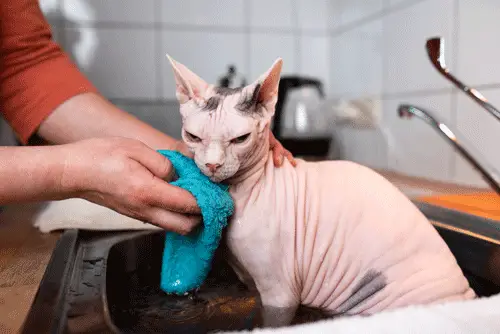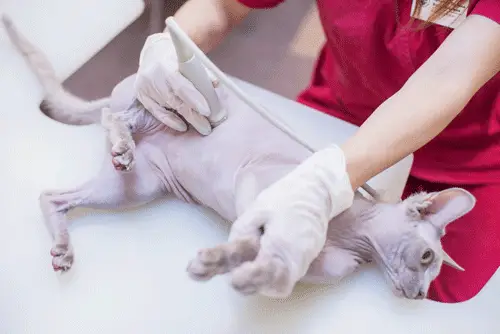You might think that Sphynx cats are less complicated and easier to care for because they don’t have any hair…think again! Their natural nakedness is a physical trait that’s very rare in cats, which also means their bodies have some unique quirks that other cats don’t need to worry about. And those quirks often mean more work in grooming, feeding and caring for your Sphynx. But as any Sphynx cat owners can attest, it’s all worth it in the end for your adorable, lovable Sphynx!
Maintaining Your Sphynx Cat’s Temperature
One consequence of not having any hair is that Sphynx cats have a harder time maintaining their body temperature. Imagine hanging out without any clothes on; it would be harder for your or me to stay warm or at a comfortable temperature as well!
It’s for this reason that Sphynx cats require a very specific room temperature of about 68 to 77 ºF, which can put a strain on the heating or air conditioning bill.
It’s also important to keep some warm, cozy items around the house such as blankets and cat beds to allow your Sphynx to snuggle up and get warm if they so choose. You might even consider trying a heating pad that can be warmed up in the microwave or an electric cat bed or blanket.
Many owners will even dress up their Sphynx cats in mini sweaters and warm clothes, which is both adorable and practical. If you do choose to dress up your Sphynx, keep in mind their clothes will need to be washed often because of their oily skin. Also, while it goes without saying, be mindful to not dress up your Sphynx if they don’t like it!
Sphynx Cats and Sunburn
Another thing to consider with a Sphynx is that they’re far more likely to get a sunburn if left outside for even a short amount of time. While most cats have a natural sun protection layer of dense hair, Sphynx cats are completely defenseless to the sun.
It’s best to just not allow your Sphynx to go outside, and definitely do NOT try to use human sunscreen on their skin as it’s not formulated for cats.
Grooming Your Sphynx Cat
You might assume that just because Sphynx cats don’t have hair you don’t have to do any grooming. That couldn’t be further from the truth! Although you won’t need to buy any brushes anytime soon, your Sphynx will need to be bathed quite often and have their nails clipped and ears cleaned.
Bathing Your Sphynx

Sphynx cats generally have very oily skin because they don’t have hair to disperse that oil. It just accumulates all over their body and if not taken care of can get on your floor, furniture, clothes, etc. And to top it off, it can have a bit of a stinky smell to it.
It’s for this reason that you must give your Sphynx a bath at least once per week in order to prevent the buildup of this oil. Be sure to use a special pet shampoo without any scents and warm water in the bath. Sphynx cats have a harder time regulating their own temperature, so it’s important to not use water that is too hot or too cold. Imagine dunking yourself into a freezing cold bath!
Also try not to bathe your Sphynx for too long because the water can dry out their skin.
Make sure to rinse off the shampoo completely as the dried residue could irritate the Sphynx cat skin. Your Sphynx might be fighting you to get out of the bath sooner, but make sure you’re completely done with the washing process before doing so, for your sake and theirs.
Pat your Sphynx completely dry after the bath. They might squirm a bit but they’ll be thankful later when they’re not damp and cold.
Cleaning Your Sphynx’s Ears
Like the rest of their body, Sphynx cats don’t have much hair in and around their ears, which causes ear wax to build up. If left uncleaned, this buildup can cause problems such as blockage of the ear canal and infections.
It’s recommended that you clean their ears right after a bath as the ear wax will be softened from the warm humidity and easier to remove. You can start by gently wiping in and around the ear with a wet wipe or cloth. Then, with a Q-tip clean out excess wax closer to the inside of the ear, but don’t press the Q-tip in too far or rub too vigorously as it’s a very delicate place.
We suggest using an ear cleaner solution specifically made for cats.
Clipping Your Sphynx Cat’s Nails
Any cat will need to have their nails clipped every so often, but it’s particularly important for Sphynx cats. Because they don’t have hair around their paws they’re more prone to having dirt build up in and around their nails. Trimming their nails as needed will help get rid of this dirt and grime and keep your Sphynx’s paws from any sort of blockage.
Using a cat nail clipper, clip the nail down as close to the quick (the pink part of the nail closer to the paw) as possible without actually clipping the quick. If you’ve never clipped a cat’s nails before or are new to the process, it’s better to err on the side of caution and give their quick a little more space. It can be really painful to a cat to have their quick nipped or exposed, and subsequently might make them despise getting their nails clipped in the future.
Preventing Acne on Your Sphynx
Because Sphinx cats don’t have an extra layer of hair to prevent dirt and outside substances from coming in contact with their skin, they’re more prone to skin infections and acne. You might notice some blackheads or developing red spots on your Sphynx cat, which are signs of the affected area.
You can scrub the area with some antimicrobial soap and warm water to help prevent further breakout.
Brushing Your Sphynx Cat’s Teeth
Sphynx cats tend to have more dental issues than the average cat, which can lead to dental disease and smelly breath. If left untreated, their teeth might have to be extracted to prevent further infection and in the worst cases they could sustain organ damage.
It’s recommended that you brush your Sphynx’s teeth at least three times per week with a special pet tooth brush and tooth paste.
Feeding Your Sphynx Cat

Along with their unique appearance, Sphynx cats have a very high metabolism and will need to be fed more often than the average cat. This is partially because they have to expend more energy to keep themselves warm without any hair.
Because they eat more, serving them only dry food might only lead to dehydration, so incorporating more of a wet food diet is a good idea.
Not only that, but they tend to have sensitive digestive systems so they will likely require a specialized diet. A specially formulated cat food can also help cut down on their oiliness of their skin and prevent skin problems such as rash and breakouts.
Ask your vet or breeder for some suggestions on which brands to try. Every Sphynx is different, so it might take some time and trying a few options to find the right one.
Keeping Your Sphynx From Getting Lonely
It’s true that Sphynx cats are physically quite high maintenance, but they’re also psychologically high maintenance as well. They’re extremely social and affectionate cats, and require a lot of attention and interaction to keep them from getting lonely.
Be prepared to get plenty of cat toys, trees and houses and play with your Sphynx cat often. Keeping them engaged with plenty to do will keep them out of trouble and from getting bored or depressed.
While it’s incredibly endearing and cute for your Sphynx to follow you around the house and sleep in bed with you, it also means that they could be suffering from loneliness while you’re away. Many Sphynx cat owners will get another Sphynx or house cat as a kitty companion if they’re not home all the time. In fact, many breeders will offer a second Sphynx at a discount to encourage you to get your Sphynx a friend.
At the end of the day, a Sphynx will simply require more attention. If you’re a very busy person or don’t want a high maintenance pet, a Sphynx might not be right for you.
Regular Checkups for Your Sphynx Cat

Although your Sphynx cat might have come from the breeder with a clean bill of health that doesn’t mean the work is done. Like any purebred cat, Sphynx cats are prone to certain genetic health issues that should be monitored fairly often because early diagnosis is crucial to treatment. You might be able to detect certain health conditions yourself, but the majority of problems your Sphynx will encounter will likely not show any obvious symptoms. Cats are experts at hiding discomfort and pain, and your Sphynx is no exception. Your vet has the necessary screening tools and training to find these conditions, such as hypertrophic cardiomyopathy (HCM), dental disease, and urticaria pigmentosa.
It’s highly recommended that you schedule checkups with your vet at least twice per year. Sphynx cats are more high maintenance than other cats are more likely to develop health issues that you might not be aware of.
Some Advice for the New Sphynx Owner
This laundry list of requirements for your Sphynx cat might seem overwhelming, and it is! Sphynx cats require a lot of care and attention, but for many people it’s well worth the cost of owning a Sphynx.
Don’t be afraid to ask your breeder for plenty of advice when you first get your Sphynx kitten or cat. They’ll be more than happy to provide all the information you need to give your Sphynx the best life possible.
You can also use your vet as a resource for which products to buy and how to perform any of the necessary grooming above. They’ll show you how to clean your Sphynx’s ears and some best practices on how to clip their nails. While it may seem daunting at first, with some practice and time you’ll become the best Sphynx owner you can be!














